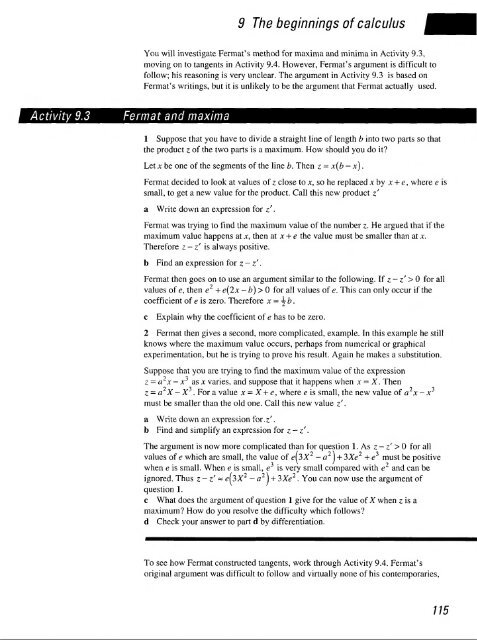history of mathematics - National STEM Centre
history of mathematics - National STEM Centre
history of mathematics - National STEM Centre
You also want an ePaper? Increase the reach of your titles
YUMPU automatically turns print PDFs into web optimized ePapers that Google loves.
Activity 9.3 Fermat and maxima<br />
9 The beginnings <strong>of</strong> calculus<br />
You will investigate Fermat's method for maxima and minima in Activity 9.3,<br />
moving on to tangents in Activity 9.4. However, Fermat's argument is difficult to<br />
follow; his reasoning is very unclear. The argument in Activity 9.3 is based on<br />
Fermat's writings, but it is unlikely to be the argument that Fermat actually used.<br />
1 Suppose that you have to divide a straight line <strong>of</strong> length b into two parts so that<br />
the product z <strong>of</strong> the two parts is a maximum. How should you do it?<br />
Let x be one <strong>of</strong> the segments <strong>of</strong> the line b. Then z = x(b — x).<br />
Fermat decided to look at values <strong>of</strong> z close to ;c, so he replaced x by x + e, where e is<br />
small, to get a new value for the product. Call this new product z'<br />
a Write down an expression for z'.<br />
Fermat was trying to find the maximum value <strong>of</strong> the number z. He argued that if the<br />
maximum value happens at x, then at x + e the value must be smaller than at x.<br />
Therefore z — z' is always positive.<br />
b Find an expression for z - z' •<br />
Fermat then goes on to use an argument similar to the following. If z - z' > 0 for all<br />
values <strong>of</strong> e, then e 2 + e(2x -b)>0 for all values <strong>of</strong> e. This can only occur if the<br />
coefficient <strong>of</strong> e is zero. Therefore x = -^ b.<br />
c Explain why the coefficient <strong>of</strong> e has to be zero.<br />
2 Fermat then gives a second, more complicated, example. In this example he still<br />
knows where the maximum value occurs, perhaps from numerical or graphical<br />
experimentation, but he is trying to prove his result. Again he makes a substitution.<br />
Suppose that you are trying to find the maximum value <strong>of</strong> the expression<br />
z = a 2x - JC 3 as A: varies, and suppose that it happens when x = X. Then<br />
z = a 2X - X 3 . For a value x = X + e, where e is small, the new value <strong>of</strong> a 2x - x 3<br />
must be smaller than the old one. Call this new value z'.<br />
a Write down an expression for z'.<br />
b Find and simplify an expression for z - z' -<br />
The argument is now more complicated than for question 1. As z - z' > 0 for all<br />
values <strong>of</strong> e which are small, the value <strong>of</strong> e(3X 2 — a 2 ) + 3Xe 2 + e 3 must be positive<br />
when e is small. When e is small, e is very small compared with e 2 and can be<br />
ignored. Thus z-z' ~ e[3X 2 — a 2 j + 3Xe 2 . You can now use the argument <strong>of</strong><br />
question 1.<br />
c What does the argument <strong>of</strong> question 1 give for the value <strong>of</strong> X when z is a<br />
maximum? How do you resolve the difficulty which follows?<br />
d Check your answer to part d by differentiation.<br />
To see how Fermat constructed tangents, work through Activity 9.4. Fermat's<br />
original argument was difficult to follow and virtually none <strong>of</strong> his contemporaries,<br />
775
















